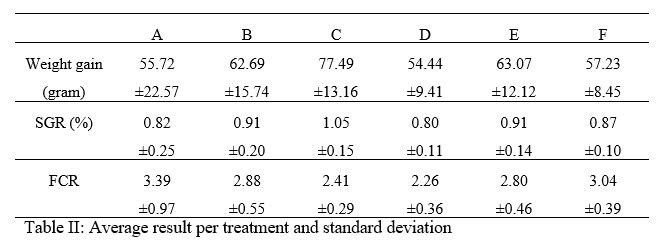INCORPORATION OF BLACK SOLDIER FLY LARVAE (Hermetia illucens) IN THE DIET OF OMEGA PERCH (Therapon barcoo)
Introduction
Due to the high need and inclusion of fish oil and fish meal in diets of most cultivated fish in our Western world, much more kilogram of fish are used to produce these fish than they produce (Van Hoestenberghe et al. 2013). For many fish species in the wild, insects are a substantial part of their natural diet. Insects can be a new alternative for fish meal in aquaculture diets. Black Soldier Fly (Hermetia illucens) pre-pupae meal might be a suitable alternative for fish meal due to the amount of protein, fat and well balanced essential amino acid profile (Kroeckel et al 2012). The use of Black Soldier Fly in aquaculture nutrition could contribute significantly to the sustainability of fish farming by lowering pressure on natural fish stocks, as well as by converting organic side streams (from agriculture, fruit and vegetable processing facilities, retail,..) to nutritionally valuable feed ingredients. The Omega Perch (Therapon barcoo) is an aquaculture species new for Europe that performs well in recirculating aquaculture systems (RAS) and feeds on grow-out diets with very low or no dietary levels of fishmeal and fish oil. The present study was undertaken to compare production parameters of Omega Perch fed on diets with different mix ratio between Black Soldier Fly larvae and extruded feed pellets.
Materials and methods
360 omega perches of 96±3.49 gram were obtained from the fish farm "AQUA4C". They were distributed over 18 tanks at a density of 13.8kg/m³. Tanks were connected to a RAS and photoperiod was 13 hours light/11 hours dark. Water temperature was maintained at 27±0.5°C and measurements of oxygen showed an average value of 7.6±0.3mg/l. Other water quality parameters that were monitored during the trial were ammonium (0.5±0.3mg.l-1), nitrite (0.3±0.2mg.l-1), nitrate (74.5±37.1mg.l-1) and pH (8.2±0.1). Feed was supplied to the tanks by an automatic belt feeder every half hour during ten hours. The six experimental treatments differed from each other in the mix ratio of extruded pellets and fly larvae (mix ratio are shown in Table I) with each three replicates. Fishes were weighted at start of trial and every two weeks till the end of the trial, eight weeks after start. Daily feed gift was based on the biomass weighted at the start of each period with feed ration being 3.2% in the first period, 2.8% in the second and third period and 2.6% in the fourth period. Two millimeter pellets of an extruded plant based feed formulated by AQUA4C were used as part of the diet. Every week a fresh batch of Black Soldier Fly larvae, produced on fruit and vegetable waste from retail, were obtained from Millibeter. The corresponding quantity of Black Soldier Fly larvae to give to the fish, according to the percentage shown in Table I, was divided by 0.4 to compensate for the 60% of moisture-content of the larvae. This was not done for treatment D. Prior to weighing the feeds, the needed amount of fly larvae were frozen for half an hour to facilitate control over the larvae on the feeding belt.
Results
Table II shows the average weight gain over the full period of the eight week trial for all treatments. Treatment (C), where fish received 50% of feed ration in extruded pellets combined with 50% of feed ration in larvae dry weight, have gained the most weight. Treatment C also had a higher specific growth rate than the others treatments, however not significantly different.
Discussion and Conclusion
To quantify the uneaten fly larvae, too much manipulation in the fish tanks would have been needed that could have led to stress and interfere in the trial. For this reason high feed ration was used to assure enough feed in all tanks. This could also explain the high FCR, as it does not reflect the eaten feed, but the applied feed. The results of this study show that Black Soldier Fly larvae can be included in the diet of Omega Perch. With exception of treatment D, all combination treatments of extruded pellets and larvae had higher growth then both 100% single compound treatments. This could indicate that both feeds contain some nutritional elements that are unavailable or lacking in the other. By combing these diets, a higher variety of nutrients is available to the fish, probably leading to a better growth.
References
Kroeckel S., Harjes A.-G. E, Roth I., Katz H., Wuertz S., Susenbeth A. and Schulz C. 2012. When turbot catches a fly: Evaluation of a pre-pupae meal of the Black Soldier Fly (Hermetia illucens) as fish meal substitute - Growth performance and chitin degradation in juvenile turbot (Psetta maxima). Aquaculture 364-365: 345-352
Van Hoestenberghe S., Roelants I., Vermeulen D. and Goddeeris B.M. 2013. Total replacement of fish oil with vegetable oils in the diet of the juvenile Jade Perch Scortum barcoo reared in Recirculating Aquaculture Systems. J. Agri Sci. Tech. B3: 385-398

